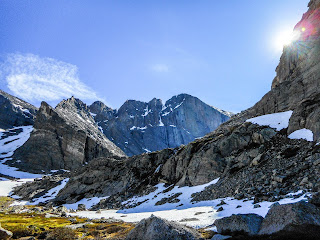The "Keyhole Route" is over 14 miles and 5,000 feet of elevation gained/lost to and from the Longs Peak trailhead. This route also includes serious hazards such as exposure, loose/falling rock, altitude, lightning storms, "no fall zone" scrambling, and crowds. So, what does this mean for preparation? Here are a few tips to help you be successful on this route:
1) Find a specific mountain workout program that works for you, and stick to it
There are many workout programs available in the modern era that are specific to mountain fitness. Programs like those available on uphillathlete.com cater to a variety of different mountain objectives and can help you get more targeted training. Given the Keyhole Route has no 4th or 5th class climbing, seek programs that focus on cardio and moderate intensity workouts for longer periods of time.
A hiker enjoying the early morning sun on Longs Peak.
2) Progress gradually into climbing Longs
There are a plethora of moderate peaks from 12-14,000 feet in Colorado that are shorter and require less elevation gain/descent than the Keyhole, start smaller and work into Longs. 14ers such as Grays and Torrey's Peak offer routes about half the hiking distance of the Keyhole Route and don't engage any third class terrain. Getting comfortable with exposure and 3rd class scrambling is best done through a progression at lower altitudes in less consequential terrain before engaging the Keyhole. There are certain sections of the Keyhole route where an unroped fall would be fatal.
Peaks like Hallett (in the upper left of the photo) offer hiking routes that are great preparation for Longs. Photo Chris Brinlee.
3) Acclimatize
Some would argue acclimatizing before you climb a 14er is a no brainer, but Colorado's easy road access to higher elevations can make acclimatizing an after thought. If you live near sea-level, consider spending a minimum of 3-5 days gradually increasing the altitude you are sleeping and hiking at. There is no golden rule regarding the exact timeline needed, everyone acclimatizes at different rates, so make sure to check in with yourself and your hiking partners with symptoms of acute mountain sickness and HAPE (HACE is less likely at and below 14,000 feet). As always, DESCENT is the only treatment for altitude illness.
An AAI climber enjoys the summit of Longs Peak at 14,259 feet above sea level after climbing the North Face. This was after a full week of hiking and climbing at lower elevations.
4) Plan for the right time of year
The Keyhole is dramatically different depending on the time of year. Late summer is the only recommended time of year for people looking to keep the difficulties of the route at third class, with August and September generally being best. The Keyhole is much more serious route in the fall, winter, and spring involving crampons and an ice axe. The late summer timeframe presents a heightened hazard from lightning storms, so check the weather forecast! Conditions of the Keyhole route are posted and shared online through the National Park Service.
August on Longs Peak, offering dry, less snowy conditions.
4) Bring the right gear
I commonly see two extremes on the Keyhole: people bringing too little and people bringing too much. The crucial items are:
-2+ liters of water (you can and should refill your water at the Boulderfields later in the summer, bring water purification tablets as well.)
-1,200+ calories worth of food (most people will have a caloric deficit by the end of their Longs trip- bring LOTS of food!)
-Cell phone with a gps app such as GAIA (a paper map is always welcomed too)
-Synthetic (no cotton) pants and shirt
-Lightweight and medium weight insulation
-Hardshell waterproof jacket
-Medical Kit
-Sunglasses and Sunscreen
-Trekking pole(s)
-Climbing Helmet (you will see very few people wearing one, but there is significant hazard of rockfall, etc. especially from other scramblers)
-SOS beacon (verizon cell signal is great for some of the climb, but there are several areas where cell service is unreliable).
5) Start your preparation ASAP
Somebody new to long days at altitude should think about physically and mentally preparing for Longs 6 to 12 months in advance, at a minimum. Many people will want to start even earlier. The better prepared one is for a climb like this, the more they will enjoy it. This is a serious endeavor so if you're in doubt of the hazards, choose a smaller objective or consider hiring a guide. Preparation also includes, RESEARCHING the specifics of the Keyhole Route, many resources are available providing photos and details regarding the route.
The Keyhole Route is a classic route that most would argue is a must-do for anyone- whether you identify as a hiker, scrambler, and/or a climber. Be patient with your preparation and never push into terrain you do not feel comfortable with.






No comments:
Post a Comment